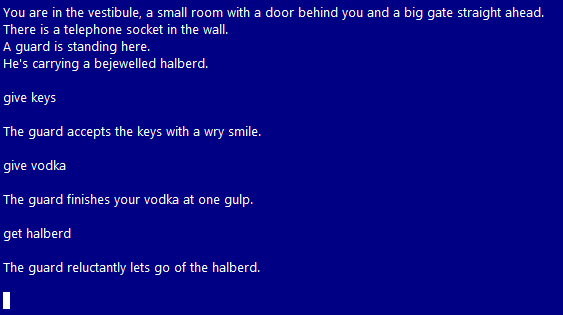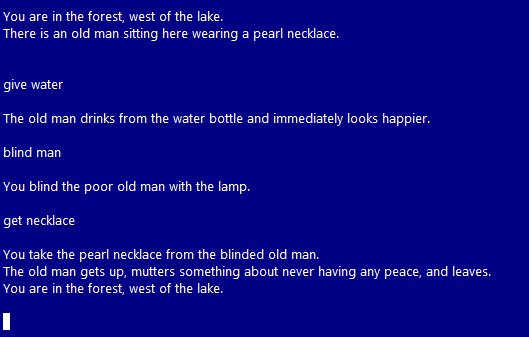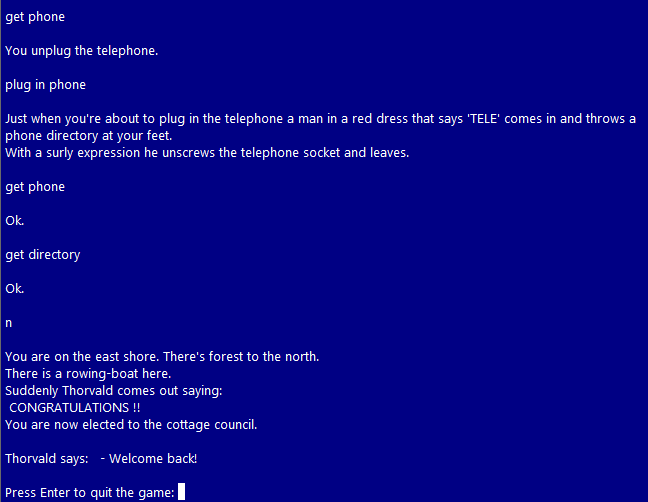After that little detour into Richard Garriot's DND1, it's time to get back to my regular schedule with the similarly-named MUD1. MUD1 (which stands for Multi-User Dungeon) was created by a student named Roy Trubshaw in 1978 at the University of Essex, on a DEC PDP-10 mainframe (with development later handed over to another student, Richard Bartle, in 1980). Trubshaw had been a fan of Zork, and indeed MUD1 was named after that game when its original title was Dungeon. And much like Zork, it's a hugely influential part of gaming history.
While it's not the first multi-player game (I've already covered a few in the course of the blog, including Orthanc, Moria and Oubliette ), it is the first to be completely text-based, in the same style as Colossal Cave Adventure and Zork. It inspired a whole genre of similar games, called MUDs after their progenitor. I don't think I'll be playing those, as single-player games are really my bread-and-butter. I was curious about the first one, though, as it's of extremely high significance. Perhaps I can be swayed on some of the others.
The original game was shut down in 1987, so obviously I'm not playing that one. The version that I'm playing is the one hosted at https://www.british-legends.com/CMS/, which was ported to modern platforms in 2000 by a fellow named Viktor Toth. I don't know how accurate it is to the original, but that's a problem with all of these mainframe-based games. They underwent constant development, and the originals are most likely lost to the ages. It's sad, but we make do with what we have. It's great that the game is available in any form, really.
MUD1 starts with a rather familiar premise: you must explore a fantastical land (called The Land, which might be a nod to Stephen Donaldson's Thomas Covenant series, though it's generic enough to be a coincidence), and collect treasures. These treasures must be dropped into a swamp to score points, which doesn't make a lot of sense, but I can roll with it. Nearly every text adventure I've played for the blog has this "plot", so it's something comforting for me to cling to in this terrifying multi-player world.
After some preamble where you have to give yourself a name and a gender, the game opens in an Elizabethan Tearoom, quite cozily described, with exits in all directions. I've watched my son play a load of Fortnite recently, and I guess that this room is analogous to the "lobby" in that and other more modern games. (Yes, I'm an old man who doesn't do on-line gaming, isn't that obvious yet?)
 |
| The "lobby" of MUD1. Another player named Scrofula entered and left while I was getting a screenshot. |
I headed north, emerging in a dense forest, and proceeded with my usual method of mapping out the locations and interesting items and landmarks. The first thing I was struck by is the descriptive quality of the writing. After the terse adventure games on home computers of this vintage, and the garbled English of The Cottage, this was a massive relief. The game has a real sense of place and logical design, and just feels more "real" than almost any other game I've played so far. It's also very good about describing what you can see in the distance. Only Zork evoked something similar, so I can see why a lot of people spent their time here.
It's also a lot more dynamic than its contemporaries. Creatures roam about the land: a viper, a rabbit, dryads, and others. It rains occasionally. I don't know if these elements are puzzles or just background detail, but they add to the sense of a virtual world. I've been attacked and killed by the dryad, and poisoned by the snake when I tried to pick it up, so it's likely that they're obstacles I need to overcome or avoid.
I spent about two hours exploring and mapping, and I get the sense that there's still a lot that I haven't seen. Here are some of the more interesting landmarks:
- A rusted railway track, with hints that it leads to an old mine. I found a golden bolt in a section of track, which is probably a treasure.
- A maze-like pine forest, with a whole load of interesting areas. For reasons I'll get into, this wasn't as difficult to map as the mazes in some other adventures have been.
- A bandstand deep in the pine forest, with a conductor's baton and a parasol.
- An empty birdbath in the pine forest.
- The entrance to a badger's den. I tried to enter, but something clawed my face and forced me to retreat. There's a lucky rabbit's foot on the ground nearby.
- An apple tree in the pine forest, complete with golden apple.
- A jetty, with an empty lobster pot. There's no boat there, but the game does suggest that I'll need one if I'm to go on the water.
- A mausoleum overgrown with moss.
- An onyx statuette of a lion, featuring a message telling me that I should drop it in the "forest of death".
- A shrine in the pine forest. The description suggested that I ought to meditate there, which I'll definitely do once my initial explorations are done with.
- A sundial in the pine forest.
- A goat tied up in a pasture.
- A blind, deaf, and dumb beggar.
- An ebony staff found on a stony beach.
- A misty graveyard, which I got lost in. Wandering around it I saw a lot of random gravestones, with messages that give hints as to various puzzles and dangers in the game. I'll need to take more notice of them when I go back there.
It's plenty to go on already, but I suspect that the game has a lot more to offer than that. It's standard adventure game fare, but the quality of the writing lifts it above the norm. I'm intrigued by a lot of this stuff in a way that I haven't been by most of the adventure games I've played for the blog.
Mechanically the game is very solid as well. I'm yet to have any parser issues (though I'm in mapping mode at the moment, so I haven't tried a lot). It has one innovative command that I've found really useful: if you enter X, it gives a list of the area's exits as well as their destinations. It's somewhat mitigated by the game using the same title for a lot of areas (I've encountered 11 different versions of "Dense Forest" so far), but it's still a large boon to mapping, and was really helpful for me in the pine forest. I hope it's something that catches on as adventure games develop.
The only mechanical thing I'm a little annoyed with is combat. You can initiate it with any other creature, and it cycles through various attack and their results until one side is dead, or you interrupt it with a command. It's not that bad, and the ability to run away is a real help, but the problem is that other creatures can attack you as well. Twice now I've been set upon and killed by a dryad while trying to map the woods. I prefer adventure games without random elements, if possible.
The only other thing to talk about is the presence of other people in the game. Early on I encountered someone called "Salacious the Witch", who wandered around and gave me a bunch of hints. At first I thought she was part of the game, so I ignored her, but I'm pretty sure now that she was another player. Later on, when I was lost in the graveyard, someone named "Scorpio" started trying to engage with me. He said "hi", and I ignored him. He teleported to my location somehow, and I continued to ignore him. He tried to give me hints about why I was lost. He handed me a rattle. At that point, I quit the game.
To be honest, I found it a bit unnerving. I don't like on-line games, and stuff like this is why. He was just trying to be friendly, but I wasn't interested. I just wanted to play on my own, you know? In games, as in life, I just want to be left the fuck alone. So sorry Scorpio, I was probably very rude. I don't say hello to people when I walk past them at work, either. I understand that for a lot of people this was probably the main attraction of the game, but I just want to solve puzzles and explore in solitude. I get more than enough human interaction in real life.
Aside from the unwelcome intrusions of Real Humans, I've enjoyed MUD1 a lot so far. It's a well-crafted environment that's fun to explore. I'm not sure if it holds up as a game, but I'll find out once I start tackling some puzzles. You know, as long as too-helpful people stay out of my way.



















